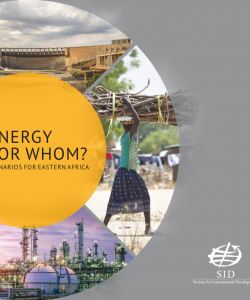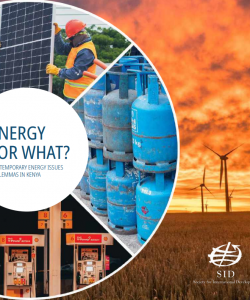
Energy for Whom? Scenarios for Eastern Africa
According to the International Energy Agency’s Africa Energy Outlook 2014 publication, “More than 200 million people in East Africa are without electricity, around 80% of its population. Ethiopia, Kenya and Uganda are among the most populous countries in East Africa and have the largest populations both with and without access to electricity.”
In 2016, SID launched an ‘Energy Futures’ initiative that sought to look at possible future scenarios for energy and how these would affect energy poverty in four selected countries of Eastern Africa.
The results of this initiative will challenge the conventional wisdom that positive social and economic development can be expected soon after the grid is expanded. Even though national power grids are expanding, the quality of power that is on offer still leaves much to be desired. Frequent brownouts and blackouts mean that the national grid cannot be relied on. Furthermore, and perhaps more importantly, the cost of energy from the grid is still priced beyond the reach of many East Africans. This makes a mockery of the fanfare that has accompanied the electrification programmes and ignores an emerging reality of smaller micro- and mini-grids that are providing affordable power to local communities. Relying mostly on renewable sources for energy generation, they offer an alternative paradigm to the large power-generation projects that are being pushed by the governments.
The analysis emerging from this initiative and the three scenarios presented challenge us to imagine different ways the region might meet its energy needs in the period towards 2050 within a context of complex political and economic transitions coupled with looming ecological and climate limits.
Scenarios stories preview
- Mitumba is a world in which the big energy technologies of the 20th century take the lead in creating a new energy system. For a while, this looks successful, but forces beyond the control of decision-makers ultimately undermine the gains that have been made. The wife of a successful economist describes what happens.
- Markets explores the excitement of building a new energy system that responds to the climate limits of the 21st century. This story is told by a young reporter and their older mentor who encourage markets to decide what investments are made and describe who benefits. It is, in many ways, a technological success, but comes at a high price for Eastern African societies.
- Struggles is the story of an energy engineer and his wife who leave the capital to create a more meaningful life in a small rural city. They describe a life of quiet social innovation, extreme crises and local responses that create a very distributed energy system. It is a political experiment that begins to rebuild the shattered centre of national government.
These stories are not predictions. They are tools. They have been written to stimulate conversation about the choices our societies face today. They anticipate possible future events in order to better respond to them. They can be used by any individual or organisation to test their own plans and choices. We offer our stories and analysis here in hopes that they will serve this purpose well.
The report was launched on 14th September 2018, in Nairobi (Kenya) and has been produced by the Society for International Development with the support of The Heinrich Böll Stiftung, East and Horn of Africa Regional Office.

